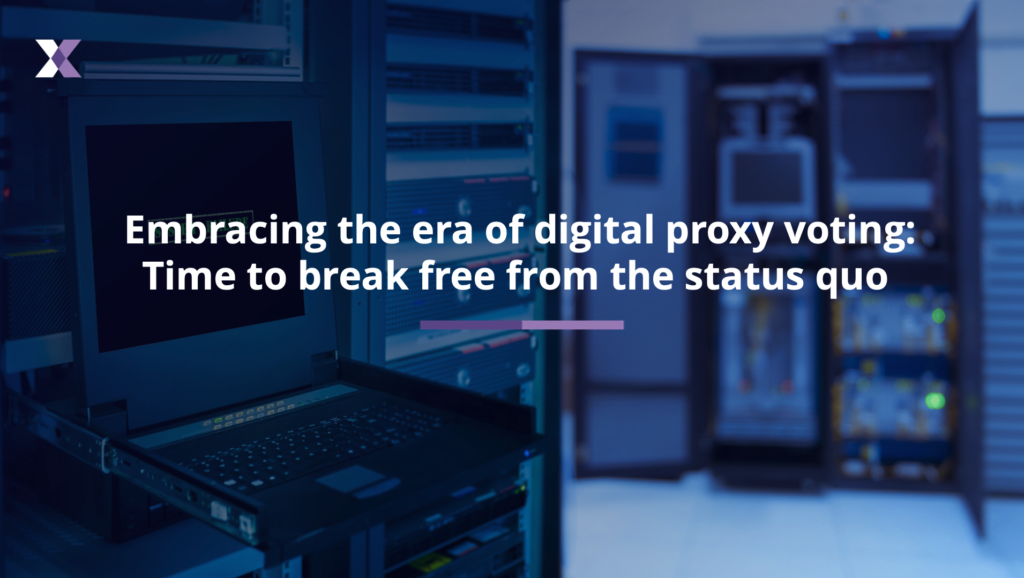Views
Embracing the era of digital proxy voting: Time to break free from the status quo

Shareholders today expect to be heard. We also know that younger, more active shareholders are increasingly compelled to exercise proxy voting rights than ever before, as shareholder democracy gains traction around the world This trend is amplified by the increased focus on ESG matters, with Harvard Law School reporting an increased number of ESG proposals in the 2022 proxy season.
This means that issuers are under increased pressure to proactively manage the chain through which votes are processed.
The current proxy voting system is thwarted by inefficiencies and excessive costs, particularly when dealing with local markets or cross-border voting. The lengthy chain of custody and the potential for misinterpretations and errors in transmitting crucial information undermine corporate stewardship and shareholder engagement.
The impact of this, and the inefficiencies when the process runs on legacy systems, all hinder true shareholder democracy.
What’s needed is a digital transformation of the proxy voting ecosystem to meet the growing demands of the shareholder community.
Where do legacy systems fail?
It is widely recognised that the way proxy voting works today is inefficient and inadequate for all involved parties. There are three core ways in which legacy systems fall short, all of which can be solved by global digital transformation.
Onerous documentation
Tight deadlines and the sheer amount of documentation before and after a general meeting can weigh heavy on legacy systems. Manual processes increase the risk of misinterpretations and inaccuracies, leading to potential disputes and challenges to the validity of votes.
In many cases, investors cannot determine if their votes were cast as they intended, and issuers cannot rapidly determine the outcome of close votes. Many votes can be disqualified due to mismatches or other record keeping errors.
Research shows that 75% of issuers have seen cases of ‘lost’ votes, where shareholders say they have put forward their votes, but they do not emerge from the chain and 61% say that they have seen meeting notices fail to reach institutional shareholders.
Add the demands of the latest SWIFT Standard ISO 200222 and you have more compelling reasons to consider the switch up to a centralised, digital platform.
Long and complex chain of custody
The traditional proxy voting process involves multiple custodians, including issuer, issuer agent, issuer CSD, sub custodians, global custodians, vote advisories and investors, which can introduce delays, errors and added costs.
Each transfer of custody introduces a risk of misplaced, lost, or mishandled votes, potentially disrupting and compromising the accuracy and validity of the voting process.
There is also a risk of information gaps which hinder voters from making informed choices. Research has shown that 24% of announcements are reaching investors incomplete.
When voting across borders, the chain of custody becomes longer. The need for verification procedures and documentation can contribute to higher expenses for all parties and companies cannot always tie costs of a vote back to the size of the shareholder base.
Poor corporate stewardship and shareholder engagement
The UK Stewardship Code (the “Code”) is a voluntary code, but investors increasingly recognise the need to exercise votes with a view to enhancing long-term investment values. Together with the rise of shareholder activism, this creates a demand for greater transparency and security of vote execution.
Research suggests that proxy voters have on average 21 to 23 fewer days to vote or confirm attendance at a meeting than those who hold their shares directly. With legacy systems in place, voting results may be delayed, research may be rushed, last minute changes may cause disruption, and the timely implementation of important corporate decisions may be hindered.
There is also a lack of visibility throughout the process for issuers until the market deadline and companies cannot directly communicate with the bulk of their investors. Research shows that 60% of institutional investors say they lack the time to properly fulfil their stewardship responsibilities.
This lack of transparency and traceability in the current system erodes shareholder trust and engagement. Shareholders may feel disconnected from the decision-making process and are less inclined to actively participate, undermining the principles of shareholder democracy.
The solution: global digital transformation
By adopting global digital solutions, the need for physical documentation is minimised and the potential for human errors and misinterpretations is significantly reduced. Mobile applications and online platforms allow shareholders to easily review proxy materials, access relevant information and cast votes from anywhere at any time.
Shareholders can access real-time updates on voting issues and results, enhancing transparency and enabling active participation. Digital transformation supports comprehensive auditing and verification, ensuring the integrity of the entire voting process.
The journey starts here: Register for the GC webinar
Digital transformation enhances shareholder engagement and encourages broader participation in corporate decision-making but slow uptake of more advanced infrastructures by the ecosystem poses a major challenge.
The journey to a digitally transformed proxy voting landscape starts with Proxymity. Our solutions have been adopted and invested in by some of the largest financial institutions in the world, resulting in streamlined operations, enhanced shareholder engagement and improved corporate stewardship.
To learn more about the topics discussed in this article and hear from experts in the field, register for our upcoming GC webinar: The era of global proxy voting transformation on June 15th.

